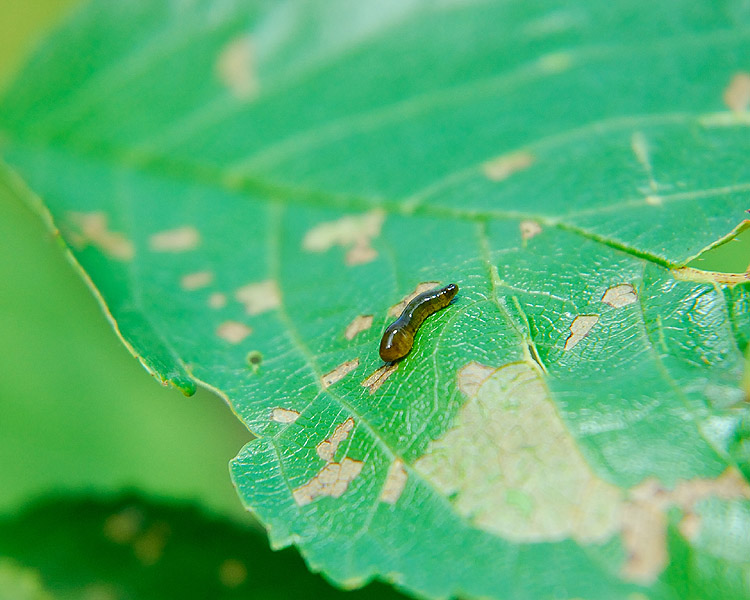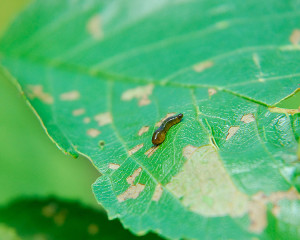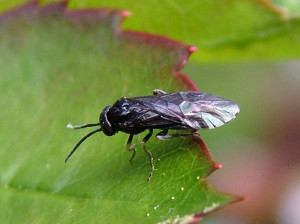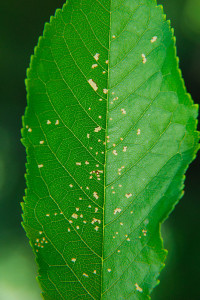This weekend the weather couldn’t have been more perfect. Now that all the poultry projects are complete we turned our attention back toward the orchard. We still have a lot of work to do. The most important task is wrapping up our never-ending irrigation project, so that was our primary goal this weekend. As we were setting up our clog-resistant Netafim™ drip irrigation lines around our Stella Cherry tree, we noticed lots of small irregular holes on some of the leaves. Closer inspection revealed the culprit, the Pear Sawfly larvae (Caliroa cerasi).
No, it’s not a slug, although it is sometimes referred to as the ‘pear slug’ or ‘cherry slug’ due to its slimy appearance. There are many different sawfly species, but this particular one has a predilection for the leaves of cherries and pears. In orchards, this pest may also affect plums, apples, and quince.
The Pear Sawfly is a new pest to us, so it warranted a little research. As we manage the orchard organically, the first thing we needed to do was understand this particular pest’s life-cycle.
The Pear Sawfly larva pupate and overwinter in the soil. Come spring, the adult flies emerge, and the females lay their eggs on the upper surface of the leaves toward the top of the canopy (where short people like me may not readily see them).
The eggs hatch within two weeks, and the larvae feed on the leaves, skeletonizing them by removing all of the leaf tissue except for the fine mesh network of veins. When mature these larvae measure approximately 1 cm in length, and lose their slimy coating, making them more caterpillar than slug-like. The larvae drop to the soil to pupate, and the cycle begins again. Typically with this species, there are two generations per year. The first emerging between June to July, the second between August and September.
Severe infestations can cause extensive defoliation of affected trees, which in turn can decrease bloom, and subsequent fruit-set the following spring.
The good news is that most often this pest is under effective biological control, as the Pear Sawfly has many natural enemies. Overall our orchard, thus far, is minimally effected. The Stella cherry, and three of the four varieties of pears in the orchard show some leaf damage, but the total number of affected leaves is relatively small.
For control within the orchard, the trees will need repeated surveillance throughout the growing season, and any larvae that are seen can be washed from the leaves with a strong jet of water, or if the infestation becomes more severe, spot treatment with an insecticidal soap is reportedly effective, providing larvae are present on the leaves. Once the mature larvae fall to the ground, controls are ineffective.
In time, as we continue to encourage more beneficial creatures to take up residence in the orchard and gardens, we hope this problem will be self-limiting, but in the meantime we’ll continue to monitor our fruit trees for signs of additional damage.














Dear Clare, Eternal vigilance are your watchwords. It seems to me that there is never a spare moment at Curbstone Valley what with chicken watching, deer repelling and now creepy crawly controlling. It makes me exhausted just thinking about it all!!
That’s alright Edith, some days we’re exhausted too! 😛 I’m sure we’re accomplishing things around the farm, but often it seems the list of things to do grows longer, not shorter!
Hi Clare
When I saw the title of your post I wasn’t sure what to expect when I clicked on it. I’ve only known of the destruction in this garden from the salix sawfly and it striped a whole salix tree leaves in one day on me many years ago.
Glad to here that there are many natural predators for this little “slug” in your area and that there’s not too much damage to your trees.
Will you have to grow some special types of flowers etc quite near the bases of the tree to entice these predators into the orchard?
The funny thing is, all the references I’ve found say the Pear Sawfly has ‘a number of natural predators’. Unfortunately, this species hasn’t been studied enough to determine WHO these predators are. The presumption I think is a diverse array of insect eating birds, parasitoid wasps, mites, and ‘other’ beneficial bugs, perhaps like our resident soldier beetles. I think the best thing we can do is not spray (as any insecticides, even insecticidal soaps can harm beneficial species), and ensure that we have a diverse array of native blooms to entice potential predators. Other than that, we cross our fingers, and keep the hose sprayer set on ‘jet’ 😛
I’ve noticed that if I don’t spray or treat I actually have fewer pest problems. We have tons of ladybugs, soldier bugs and other beneficials that seems to keep everything in check. Though it doesn’t work with trees, I also find that not only rotating crops but also scheduling the planting to avoid pests works really well.
I agree. Spraying, anything, is a slippery slope. I think if the plants are healthy, with soils amended with ample organic matter, and the ‘balance’ of bugs is maintained, that gardens (and small farms) tend to be much healthier. We do rotate the crops that we can. For the fruit trees, I think our best friend will be our astoundingly high water pressure (that has burst pipes in the house before…thank goodness for pressure regulators!). For this species, water sprays should be fine, providing the larvae aren’t yet mature enough to pupate. Look out bugs…you’re gonna get SOAKED! 😀
The beneficial bugs will definitely help out. This little creature looks very similar to one that I photoed in my yard last week. Hmmm.
They are a rather unique looking pest. I have to admit, Googling ‘cherry skeletonize slug’ yielded the answer with the top hit! As Rosie suggested, some sawfly species are more voracious in their appetites than others. If you think you have a sawfly species wreaking havoc in your garden, check with your local Agricultural or University Extension to determine which species is most common in your region. In the meantime, I’d set the garden hose on ‘stun’ 😛
There was a very enlightening talk on growing fruit trees as part of the Garden Conservancy workshop last friday. Here’s sending good vibes your way re: the sawfly.
I don’t have the speaker’s name handy, but he did reinforce the importance that I’d always been vaguely aware of – I don’t grow fruit trees myself – of being certain to match soil type and the winter chill factor (again, perhaps not the right term) when selecting trees.
Glad you enjoyed the dragonfly shot. It’s one of my favorite photos of all time!
Actually, winter chill was a very important factor when we selected varietals. It’s critical for maximizing fruit-set for your location. So much so, we consulted with an individual nearby that has a full-blown weather station, and has been tracking weather data here for years. Not to slight the USDA or local extension data, but with all the microclimates in the Bay Area, it just made sense to use a local source. Someday we hope to have a Curbstone Valley weatherstation, and tie it in to our irrigation system. We also consulted University orchardists for the optimal varietals that grow here with our sometimes foggy coastal climate. I think we’ve made good choices for this location, but as this is a ‘new’ orchard, we expect a few growing pains along the way.
So, on the one hand I agree that it’s much better not to spray, and that the natural predators often win. On the other hand, I have a neighbor who is a master gardener, does everything organically, and has 2 cherry trees. Last year, about 1/3 of the cherries had little holes and turned mushy within a few days. Turned out she had cherry vinegar fruit fly (Drosophila suzukii). She very diligently checked for dropped fruit and destroyed it (no other organic remedy for that particular fruit fly is available). This year, after carefully covering both trees with nets as the fruit started to ripen, she found that almost the complete harvest was infected and had to be destroyed. It was quite a heartbreak, she ended up with 3 cups of cherries from 2 large trees.
I’m very glad your problems are so minor in comparison.
I wonder if we get those here? I saw spots on some of my pear leaves and thought maybe they were rust. Now I’ll have to see if those creepy bugs are there.
Those leaves look just like the leaves of one of my apple trees! I will have to look more closely. No doubt some sort of sawfly thrives in our area. I have a lot to learn about these and other garden pests. Thanks for the info!
I admire how you work hard at being so in tune with nature and learn all you can about what is in your garden. People can learn a lot from you by your example…water and insecticidal soap can cure many problems without resorting to powerful chemicals.
I just smooshed a few sawfly larvae and a fly on the leaves of a beautiful hibiscus….they seem to like ornamentals, too. gail
I used to clean them off my pear tree but now it is too tall for me to reach and I just leave it alone and hope for the predators to do their job. So far it has worked, but I better go check how this year leaves are looking. Thanks for the reminder!
Oh my. Is the sawfly an introduced species or is it native here? Does it only eat the foliage or does the fruit suffer as well? Hope they’re scared off by the fire hose treatment!
There is a native California Pear Sawfly (Pristophora abbreviata), but it’s a different genus to this pest (Caliroa cerasi) which is an introduced species. With significant infestations the damage to fruit is usually secondary to excessive foliage loss, where the tree can’t produce enough energy for fruit to reach a mature size.
Never heard of the pear sawfly before…hope they don’t come to my house. Maybe they will wind down as your beneficials ramp up.
I was just out in my yard and noticed these little buggers on my quince. If it hadn’t been for this post I wouldn’t have known what they were. Just a quick flick to the underside of the leaf launches them off rather nicely!
It does seem to be the season for them in the Bay Area. So glad our post helped with the ID, I figured we couldn’t be the only ones afflicted. I wonder if they’re more prevalent in heavy rainfall years?